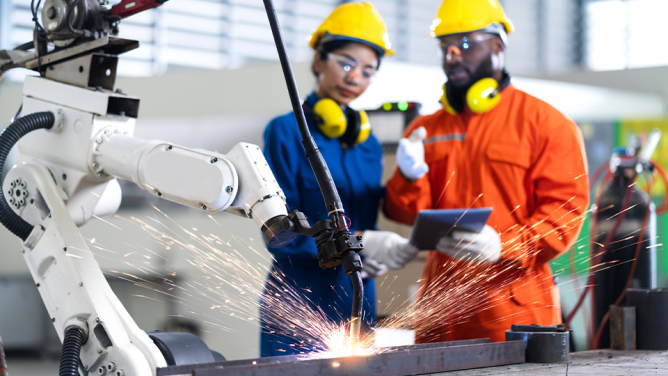It is no secret: if the climate transition and energy transition are to be successful, it inevitably means moving away from carbon-intensive fossil fuels and dramatically transforming our energy mix. The stakes are high, as fossil fuels still represent more than 80% of the global energy mix, despite efforts made to reduce this share by investing in renewable energy sources.
We are all familiar with the many ways we can decarbonize the energy mix, such as electrification, renewable low-carbon electricity production, replacing gas boilers with heat pumps, or storing clean energy with electric batteries.
These technology solutions are mature and becoming increasingly accessible price-wise. The price of solar electricity has fallen by 89% in ten years. Meanwhile, the cost of land- and sea-based wind power has decreased by 68% and 59% respectively, over the same period.
There is no denying that they have a positive impact on reducing emissions. Rewiring America is an electrification ideas lab aiming to rewire the American economy. In 2020, it estimated that replacing fossil fuels with electrification technology would reduce the country’s emissions by 70 to 80% by 2035.
However, our economic model barely takes these tried-and-tested solutions into account. For asset owners and managers, significant investment – and therefore short-term expenditure – are needed to support the energy transition which generate reductions in charges but not necessarily new rental income. The financial incentive is weak which considerably slows down the growth of carbon-free energy solutions.
Furthermore, there is often an additional operational complexity involved when implementing these solutions, which not all businesses are in a position to handle. For example, constructing a geothermal energy project involves coordinating numerous service providers, which can quickly become a headache.
Finally, if decarbonization is to be successful, the technologies implemented require long-term management in order to maintain an optimal operational level. As such, working with a professional service provider is much more straightforward for businesses.
Decarbonization-as-a-service: investing in results rather than means
In the context of energy transition, decarbonization-as-a-service (DaaS) is emerging as a paradigm likely to encourage more businesses to convert to clean energy. Behind the concept lies a model in which the business purchases carbon-free energy in the form of a service, rather than investing in energy infrastructure. This model means businesses can limit the amount of money they invest, yet also receive a better service. Take UgoWork as an example, which provides lithium batteries for the material handling market (for forklifts, industrial vehicles, etc.).
“In addition to batteries, we offer smart solutions such as a software suite to enhance use. With our 100% DaaS model, the battery belongs to UgoWork and the customer pays a monthly instalment to use our battery, software and the support service. Payment is regulated according to what energy the customer uses. The customer isn’t buying a battery, they are renting an energy service,” explains Jean-François Marchand, marketing and customer success manager at UgoWork.
With its turnkey service, this model allows the customer to benefit from a certain peace of mind. “The batteries are updated when they expire, replaced free of charge as part of the subscription package.” And they can save money too. “There is bi-directional feedback in real time with the battery and a cloud-based system. The user can send the battery instructions, like setting it to recharge during off-peak periods when there is less demand on the network, so the customer can save money with dynamic pricing.” The battery’s whole life-cycle is also taken into consideration. “We receive data via our cloud, which helps us determine and anticipate when the battery is approaching its end of life, so we can recycle the lithium cells with our partners. Around 95% of critical minerals can be recycled and reused in a new battery with the same performance.”
From batteries to solar panels
The DaaS model implies a shift for the energy supplier, from a means-based objective to a results one. Rather than just selling a product, they are committing to the service performance, of which the product is only one of the components.
This paradigm can be applied to most sectors of the energy transition. Take SunMind, which offers its clients the ability to design, finance, build and manage solar power plants on their unused land. Customers can then choose between either using this electricity themselves and benefiting from low-cost carbon-free energy, or reinjecting this energy into the grid and generating income. Meanwhile, Solarvia collaborates with local elected officials to find the most favorable sites (in terms of solar potential) for building solar farms and then develops the project in consultation with all the parties concerned. As for Poweroad, it is installing a water network in the roadway coupled with geothermal energy to benefit from the heat from the road to provide a hot water solution to communities and building owners, all on an EaaS model with financing option.. Others, like Greendeed, take on the financial engineering aspect, by getting energy certificates on behalf of customers.
Finally, “in several developing countries, particularly in Africa, the DaaS model enables companies located in isolated areas to benefit from carbon-free energy, so they avoid having to pay the required fee to connect to the grid. This is thanks to all-in-one contracts which combine the energy contract, devices and solar panel installation,” explains Adrian Gonzalez, Program Officer for Innovation & End-use Sectors at the Innovation and Technology Center in Bonn, Germany.
A model inspired by digital platform accumulated experience
This paradigm draws on the experience of digital platforms. Over the past 15 years and with the rise of cloud computing, subscription-based business models have developed, in which customers pay for IT usage and not the acquisition of devices. These services generally fall under the umbrella of “XaaS”, or “Everything-as-a-service.”
With the cloud-based model, companies can rent computing processing power via the servers of a third party company (a cloud provider such as Google Cloud, Microsoft Azure or Amazon Web Services) rather than building its own data centers was the kick off which alone explains the explosion in the number of digital startups that have been able to accelerate their access to the market by focusing solely on the final service without having to develop the infrastructure necessary for the service provided themselves. There are many similarities between these models and DaaS, such as flexibility (energy consumption can be adjusted more easily), user-friendliness and a turnkey model which means installation, maintenance and updates can be subcontracted to a third party company.
This model’s many advantages makes it a valuable asset for convincing more companies to switch to clean energy. While the energy transition may be a burden for some, it is significantly reduced with this model, as it allows customers to remain focused on their business model while they subcontract their energy to a specialist, just as you would subcontract your digital infrastructure to a cloud provider.


